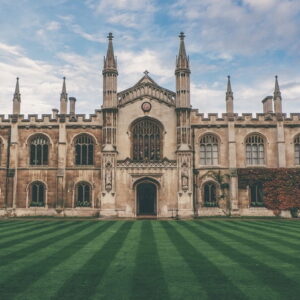
Ibram X. Kendi: How Racism Relies on Arbitrary Hierarchies
From 15th-Century West Africa to Suburban Long Island
We pulled into the parking lot, looking for signs of life. But the daily life of the school had ended hours ago. It was pushing four o’clock on that warm April day in 1990, on Long Island, New York.
The car was parked and I could see the unease in my parents’ faces as they freed themselves from their seatbelts. Maybe they were just trying to wrap their heads around making this 30-minute drive out to Long Island twice a day, every weekday, year after year—on top of their hour-long job commutes to Manhattan. I sensed their discomfort and felt my own. Nerves about changing schools. Wishing P.S. 251 went past second grade. Feeling sick being so far from home in this foreign neighborhood. My seven-year-old feelings were roiling.
Several public elementary schools resided within walking distance of my house in Queens Village. But Black New Yorkers with the wherewithal to do it were separating their children from poor Black children in poor Black neighborhoods, just like White New Yorkers were separating their children from Black children. The dueling consciousness of White parents did not mind spending more money on housing in order to send their kids to White public schools—and keep them away from the purportedly bad schools and bad children. The dueling consciousness of Black parents did not mind paying for private Black schools to keep their children away from those same public schools and children.
A Black woman greeted us at the front door of Grace Lutheran School. She had been waiting. She was the school’s third-grade teacher, and after a quick greeting, she took us down a corridor. Classrooms stood on both sides, but I fixated on the class photos outside the rooms: all those adult White faces and young Black faces looking back at us. We occasionally peeked inside nicely decorated classrooms. No sounds. No students. No teachers. Just footsteps.
She took us to her third-grade classroom, a long throw from the entrance. We could see the materials laid out for a science project, the details of which she explained to us. I couldn’t care less about raising chicks. Then she took us over to a round table and asked if we had any questions. Sitting down, my mother asked a question about the curriculum. I did not care much about that, either. I started looking more intently around the classroom. A pause in the discussion caught my attention—Dad had just asked about the racial makeup of the student body. Majority Black. I took note. My mind drifted away again, this time wandering around the classroom and around the school, trying to imagine the students and teachers, remembering those pictures in the hallway. A pause caught my attention again. A question popped out of me.
“Are you the only Black teacher?”
“Yes, but–”
I cut her off. “Why are you the only Black teacher?”
Puzzled, she looked away at my parents. My parents exchanged curious looks. I kept staring at the teacher, wondering why she was looking at my parents. Ma ended the awkward silence. “He has been reading biographies of Black leaders.”
Ma was talking about the critically acclaimed Junior Black Americans of Achievement series, promoted by Coretta Scott King. Dad had bought a stack of these biographies, towering over 100 now. Martin Luther King Jr. Frederick Douglass. Mary McLeod Bethune. Richard Allen. Ida B. Wells. Dad kept urging me to pull from the tower for every writing project.
Race creates new forms of power: the power to categorize and judge, elevate and downgrade, include and exclude.
These gripping biographies were as exciting to me as new video games on my Sega Genesis. Once I started reading, I could not stop. Discovering through these books the long history of harm done to Black Americans left me seething and brought to life a kind of racial consciousness for the first time.
“He is very much aware of being Black,” Ma made sure to add, looking at Dad. She did not look for confirmation. Dad nodded in agreement anyway, as I stared at the teacher, awaiting my answer.
In that classroom, on that April day in 1990, my parents discovered that I had entered racial puberty. At seven years old, I began to feel the encroaching fog of racism overtaking my dark body. It felt big, bigger than me, bigger than my parents or anything in my world, and threatening. What a powerful construction race is—powerful enough to consume us. And it comes for us early.
But for all of that life-shaping power, race is a mirage, which doesn’t lessen its force. We are what we see ourselves as, whether what we see exists or not. We are what people see us as, whether what they see exists or not. What people see in themselves and others has meaning and manifests itself in ideas and actions and policies, even if what they are seeing is an illusion. Race is a mirage but one that we do well to see, while never forgetting it is a mirage, never forgetting that it’s the powerful light of racist power that makes the mirage.
So I do not pity my seven-year-old self for identifying racially as Black. I still identify as Black. Not because I believe Blackness, or race, is a meaningful scientific category but because our societies, our policies, our ideas, our histories, and our cultures have rendered race and made it matter. I am among those who have been degraded by racist ideas, suffered under racist policies, and who have nevertheless endured and built movements and cultures to resist or at least persist through this madness.
I see myself culturally and historically and politically in Blackness, in being an African American, an African, a member of the forced and un-forced African diaspora. I see myself historically and politically as a person of color, as a member of the global south, as a close ally of Latinx, East Asian, Middle Eastern, and Native peoples and all the world’s degraded peoples, from the Roma and Jews of Europe to the aboriginals of Australia to the White people battered for their religion, class, gender, transgender identity, ethnicity, sexuality, body size, age, and disability. The gift of seeing myself as Black instead of being colorblind is that it allows me to clearly see myself historically and politically as being an antiracist, as a member of the interracial body striving to accept and equate and empower racial difference of all kinds.
Some White people do not identify as White for the same reason they identify as not-racist: to avoid reckoning with the ways that Whiteness—even as a construction and mirage—has informed their notions of America and identity and offered them privilege, the primary one being the privilege of being inherently normal, standard, and legal. It is a racial crime to be yourself if you are not White in America. It is a racial crime to look like yourself or empower yourself if you are not White. I guess I became a criminal at seven years old.
It is one of the ironies of antiracism that we must identify racially in order to identify the racial privileges and dangers of being in our bodies. Latinx and Asian and African and European and Indigenous and Middle Eastern: These six races—at least in the American context—are fundamentally power identities, because race is fundamentally a power construct of blended difference that lives socially. Race creates new forms of power: the power to categorize and judge, elevate and downgrade, include and exclude. Race makers use that power to process distinct individuals, ethnicities, and nationalities into monolithic races.
*
The first global power to construct race happened to be the first racist power and the first exclusive slave trader of the constructed race of African people. The individual who orchestrated this trading of an invented people was nicknamed the “Navigator,” though he did not leave Portugal in the 15th century. The only thing he navigated was Europe’s political-economic seas, in order to create the first transatlantic slave-trading policies. Hailed for something he was not (and ignored for what he was)—it is fitting that Prince Henry the Navigator, the brother and then uncle of Portuguese kings, is the first character in the history of racist power.
Prince Henry lived in me. The name Henry had traveled down through the centuries and over the Atlantic Ocean and eventually into my father’s family. After my mother gave my older brother a middle name from her family, Dad chose a middle name for me from his family. He chose the name of his enslaved great-great grandfather, Henry. Dad did not know that this ancestor shared the name of the Navigator, but when I learned the history, I knew it had to go. My middle name is now Xolani, meaning peace, the very thing Henry’s slave traders snatched from Africa (and the Americas and Europe), the thing they snatched from my ancestor Henry.
Once a race has been created, it must be filled in—and Gomes de Zurara filled it with negative qualities that would justify Prince Henry’s evangelical mission to the world.
Until his death in 1460, Prince Henry sponsored Atlantic voyages to West Africa by the Portuguese, to circumvent Islamic slave traders, and in doing so created a different sort of slavery than had existed before. Premodern Islamic slave traders, like their Christian counterparts in premodern Italy, were not pursuing racist policies—they were enslaving what we now consider to be Africans, Arabs, and Europeans alike. At the dawn of the modern world, the Portuguese began to exclusively trade African bodies. Prince Henry’s sailors made history when they navigated past the feared “black” hole of Cape Bojador, off Western Sahara, and brought enslaved Africans back to Portugal.
Prince Henry’s first biographer—and apologist—became the first race maker and crafter of racist ideas. King Afonso V commissioned Gomes de Zurara, a royal chronicler and a loyal commander in Prince Henry’s Military Order of Christ, to compose a glowing biography of the African adventures of his “beloved uncle.” Zurara finished The Chronicle of the Discovery and Conquest of Guinea in 1453, the first European book on Africa.
One of Zurara’s stories chronicled Prince Henry’s first major slave auction in Lagos, Portugal, in 1444. Some captives were “white enough, fair to look upon, and well proportioned,” while others were “like mulattoes” or “as black as Ethiops, and so ugly.” Despite their different skin colors and languages and ethnic groups, Zurara blended them into one single group of people, worthy of enslavement.
Unlike babies, phenomena are typically born long before humans give them names. Zurara did not call Black people a race. French poet Jacques de Brézé first used the term “race” in a 1481 hunting poem. In 1606, the same diplomat who brought the addictive tobacco plant to France formally defined race for the first time in a major European dictionary. “Race . . . means descent,” Jean Nicot wrote in the Trésor de la langue française. “Therefore, it is said that a man, a horse, a dog, or another animal is from a good or bad race.” From the beginning, to make races was to make racial hierarchy.
Gomes de Zurara grouped all those peoples from Africa into a single race for that very reason: to create hierarchy, the first racist idea. Race making is an essential ingredient in the making of racist ideas, the crust that holds the pie. Once a race has been created, it must be filled in—and Zurara filled it with negative qualities that would justify Prince Henry’s evangelical mission to the world. This Black race of people was lost, living “like beasts, without any custom of reasonable beings,” Zurara wrote. “They had no understanding of good, but only knew how to live in a bestial sloth.”
After Spanish and Portuguese colonizers arrived in the Americas in the 15th century, they took to race making all the different indigenous peoples, calling them one people, “Indians,” or negros da terra (Blacks from the land) in 16th-century Brazil. Spanish lawyer Alonso de Zuazo in 1510 contrasted the beastly race of Blacks as “strong for work, the opposite of the natives, so weak who can work only in undemanding tasks.” Both racist constructions normalized and rationalized the increased importing of the supposedly “strong” enslaved Africans and the ongoing genocide of the supposedly “weak” Indians in the Americas.
The other races, save Latinx and Middle Easterners, had been completely made and distinguished by the Age of Enlightenment in the 18th century. Beginning in 1735, Carl Linnaeus locked in the racial hierarchy of humankind in Systema Naturae. He color-coded the races as White, Yellow, Red, and Black. He attached each race to one of the four regions of the world and described their characteristics. The Linnaeus taxonomy became the blueprint that nearly every enlightened race maker followed and that race makers still follow today. And, of course, these were not simply neutral categories, because races were never meant to be neutral categories. Racist power created them for a purpose.
Linnaeus positioned Homo sapiens europaeus at the top of the racial hierarchy, making up the most superior character traits. “Vigorous, muscular. Flowing blond hair. Blue eyes. Very smart, inventive. Covered by tight clothing. Ruled by law.” He made up the middling racial character of Homo sapiens asiaticus: “Melancholy, stern. Black hair; dark eyes. Strict, haughty, greedy. Covered by loose garments. Ruled by opinion.” He granted the racial character of Homo sapiens americanus a mixed set of atttributes: “Ill-tempered, impassive. Thick straight black hair; wide nostrils; harsh face; beardless. Stubborn, contented, free. Paints himself with red lines. Ruled by custom.” At the bottom of the racial hierarchy, Linnaeus positioned Homo sapiens afer: “Sluggish, lazy. Black kinky hair. Silky skin. Flat nose. Thick lips. Females with genital flap and elongated breasts. Crafty, slow, careless. Covered by grease. Ruled by caprice.”
*
From 1434 to 1447, Gomes de Zurara estimated, 927 enslaved Africans landed in Portugal, “the greater part of whom were turned into the true path of salvation.” It was, according to Zurara, Prince Henry’s paramount achievement, an achievement blessed by successive popes. No mention of Prince Henry’s royal fifth (quinto), the 185 or so of those captives he was given, a fortune in bodies.
Powerful economic, political, and cultural self-interest . . . has been behind racist policies.
The obedient Gomes de Zurara created racial difference to convince the world that Prince Henry (and thus Portugal) did not slave-trade for money, only to save souls. The liberators had come to Africa. Zurara personally sent a copy of The Chronicle of the Discovery and Conquest of Guinea to King Afonso V with an introductory letter in 1453. He hoped the book would “keep” Prince Henry’s name “before” the “eyes” of the world, “to the great praise of his memory.” Gomes de Zurara secured Prince Henry’s memory as surely as Prince Henry secured the wealth of the royal court. King Afonso was accumulating more capital from selling enslaved Africans to foreigners “than from all the taxes levied on the entire kingdom,” observed a traveler in 1466. Race had served its purpose.
Prince Henry’s racist policy of slave trading came first—a cunning invention for the practical purpose of bypassing Muslim traders. After nearly two decades of slave trading, King Afonso asked Gomes de Zurara to defend the lucrative commerce in human lives, which he did through the construction of a Black race, an invented group upon which he hung racist ideas. This cause and effect—a racist power creates racist policies out of raw self-interest; the racist policies necessitate racist ideas to justify them—lingers over the life of racism.
*
From the Junior Black Americans of Achievement series onward, I had been taught that racist ideas cause racist policies. That ignorance and hate cause racist ideas. That the root problem of racism is ignorance and hate.
But that gets the chain of events exactly wrong. The root problem—from Prince Henry to President Trump—has always been the self-interest of racist power. Powerful economic, political, and cultural self-interest—the primitive accumulation of capital in the case of royal Portugal and subsequent slave traders—has been behind racist policies. Powerful and brilliant intellectuals in the tradition of Gomes de Zurara then produced racist ideas to justify the racist policies of their era, to redirect the blame for their era’s racial inequities away from those policies and onto people.
*
The teacher soon overcame her surprise at a seven-year old questioning her about the paucity of Black teachers. After searching my parents’ faces, she looked back at me. “Why are you asking that question?” she asked nicely.
“If you have so many Black kids, you should have more Black teachers,” I said.
“The school hasn’t hired more Black teachers.”
“Why?”
“I don’t know.”
“Why don’t you know?”
My parents could see my agitation growing. Dad changed the subject. I didn’t mind. My train of thought had taken me away, anyway. I was thinking about what Ma had just said. I am Black. I am Black.
I ended up attending a private Lutheran school closer to home, White third-grade teacher and all. I did not mind until I noticed.
____________________________________

From the book How to Be An Antiracist by Ibram X. Kendi. Copyright © 2019 by Ibram X. Kendi. Published by One World, an imprint of Random House, a division of Penguin Random House LLC. All rights reserved.
Ibram X. Kendi
Ibram X. Kendi is a National Book Award–winning and #1 New York Times bestselling author. His books include Antiracist Baby; Goodnight Racism; How to Be an Antiracist; and How to Raise an Antiracist. Kendi is the Andrew W. Mellon Professor in the Humanities at Boston University and the director of the BU Center for Antiracist Research. In 2020, Time magazine named Kendi one of the 100 most influential people in the world. He has also been awarded a 2021 MacArthur Fellowship.












